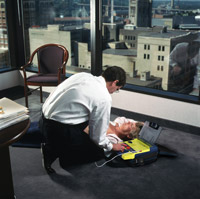AEDs in the Workplace
A February 2014 Media Release from the Minister of Health, State Government of Victoria states:
“Patients who received CPR from community members, particularly those who were treated with public defibrillators, to get their hearts beating again in the vital minutes before paramedics arrived, had even better survival rates.” The use of automated external defibrillators by members of the public on cardiac arrest patients has increased from one per cent in 2003/04 to 10 per cent in 2012/13.
“Early defibrillation by community members achieved the most favorable survival rates for people who suffer a cardiac arrest.”
As many people as possible are encouraged to receive basic training in the use of defibrillators, which are real life-savers in the event of a cardiac arrest.
“More bystanders than ever are recognising cardiac arrests and providing lifesaving resuscitation before paramedics arrive, greatly improving the chances of survival.”
 AEDs in workplaces
AEDs in workplaces
Placement of AEDs in workplaces is recommended & highly encouraged. The most significant Safety objective is to save lives however other commercial incentives include optimal OH&S, Duty of Care; Reduced Lost Time Injury; Reduced Liability; Improved Productivity with less sick leave and/or death; reduced costs associated with replacing employees.
Keeping an AED in workplace premises is as important as keeping a Fire Extinguisher, First Aid Kit and Evacuation Plan. Early access (within 5 minutes) to defibrillation is the first line of treatment in cardiac arrest.
- anyone can apply an Automated External Defibrillator and save a life
- CPR extends survival time however there is only one definitive treatment in a sudden cardiac arrest and that is a shock from a defibrillator within minutes
- it is not possible to harm someone who is in cardiac arrest because they are already deceased
- in less than 40% of emergencies bystanders take no action, often due to fear
- the time taken to defibrillation is a key predictor of survival
- without early defibrillation with an AED, less than 5% of cardiac victims survive
- an AED is safe to use and will do NO HARM – it will not deliver a shock to anyone that does not need one
- Paramedics cannot usually arrive within the vital first minutes when defibrillation can be most effective. The delay waiting for an ambulance could result in casualty not being able to be revived.
In a 2012 joint statement on EARLY ACCESS TO DEFIBRILLATION (EAD), St John Ambulance Australia, Australian Resuscitation Council and National Heart Foundation of Australia called upon federal, state and territory governments to support early access to defibrillation by
- Increasing the number of automated external defibrillators (AEDs) that are accessible in places where large amounts of people frequent, such as train stations, casinos, sporting arenas, shopping centres, fitness centres, schools etc. and develop corresponding first responder programs that support their use
- Developing appropriate performance monitoring and feedback mechanisms which evaluate the ongoing effectiveness of EAD first responder programs.
- Building community confidence in the use of AEDs through the implementation of community awareness campaigns that highlight both the misconceptions and benefits of prompt AED use.
- Mandating the registration of all private and publically accessible AEDs, at the time of purchase, with local emergency service providers
- Developing a minimum standard to regulate the deployment of AEDs within large workplaces (over 200 employees) and to train employees in both AED use and CPR.




